Transformational Leadership Moderating HR Practices in M&A Integration
VerifiedAdded on 2023/06/10
|33
|11652
|468
Literature Review
AI Summary
This literature review examines the moderating role of transformational leadership on human resource (HR) practices during mergers and acquisitions (M&As). It addresses the gap in research concerning the impact of HRM practices on employee behavior and the influence of leadership in this context. The review posits that HR practices such as communication, employee involvement, teamwork, and training positively affect employee behavior and identification with the newly formed organization. Furthermore, it argues that transformational leadership moderates the implementation of these HR practices, leading to positive employee behavior and organizational identification. The paper draws upon social identity theory to explain how M&As can threaten employees' sense of identity and organizational commitment, potentially leading to negative outcomes like decreased job satisfaction and increased turnover. It emphasizes the importance of maintaining a balance between preserving old identities and incorporating a new social identity to foster employee commitment and cooperation. The review concludes by highlighting the need for further research to empirically test the proposed relationships and gain a deeper understanding of the role of transformational leadership in M&A integration.
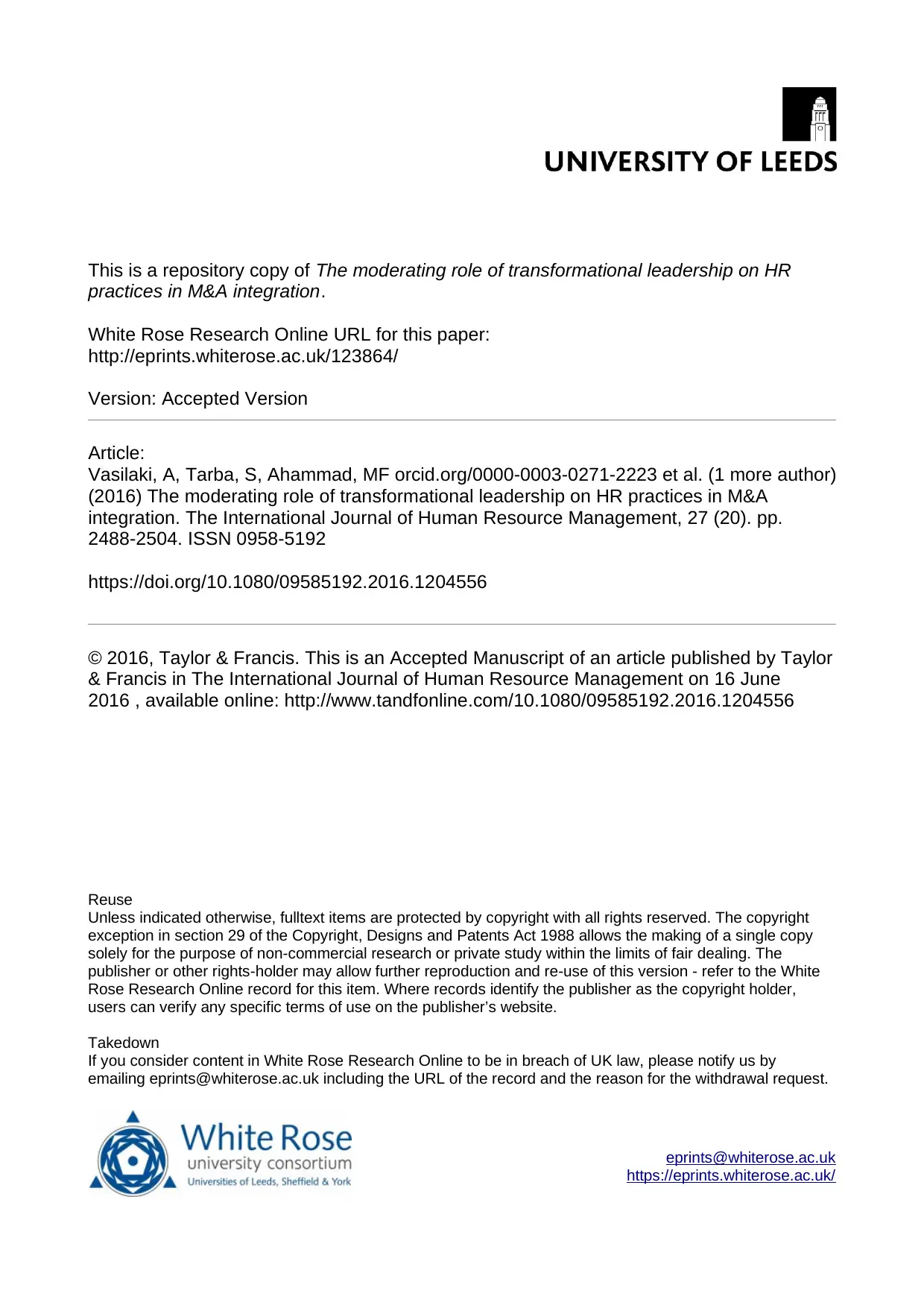
This is a repository copy of The moderating role of transformational leadership on HR
practices in M&A integration.
White Rose Research Online URL for this paper:
http://eprints.whiterose.ac.uk/123864/
Version: Accepted Version
Article:
Vasilaki, A, Tarba, S, Ahammad, MF orcid.org/0000-0003-0271-2223 et al. (1 more author)
(2016) The moderating role of transformational leadership on HR practices in M&A
integration. The International Journal of Human Resource Management, 27 (20). pp.
2488-2504. ISSN 0958-5192
https://doi.org/10.1080/09585192.2016.1204556
© 2016, Taylor & Francis. This is an Accepted Manuscript of an article published by Taylor
& Francis in The International Journal of Human Resource Management on 16 June
2016 , available online: http://www.tandfonline.com/10.1080/09585192.2016.1204556
eprints@whiterose.ac.uk
https://eprints.whiterose.ac.uk/
Reuse
Unless indicated otherwise, fulltext items are protected by copyright with all rights reserved. The copyright
exception in section 29 of the Copyright, Designs and Patents Act 1988 allows the making of a single copy
solely for the purpose of non-commercial research or private study within the limits of fair dealing. The
publisher or other rights-holder may allow further reproduction and re-use of this version - refer to the White
Rose Research Online record for this item. Where records identify the publisher as the copyright holder,
users can verify any specific terms of use on the publisher’s website.
Takedown
If you consider content in White Rose Research Online to be in breach of UK law, please notify us by
emailing eprints@whiterose.ac.uk including the URL of the record and the reason for the withdrawal request.
practices in M&A integration.
White Rose Research Online URL for this paper:
http://eprints.whiterose.ac.uk/123864/
Version: Accepted Version
Article:
Vasilaki, A, Tarba, S, Ahammad, MF orcid.org/0000-0003-0271-2223 et al. (1 more author)
(2016) The moderating role of transformational leadership on HR practices in M&A
integration. The International Journal of Human Resource Management, 27 (20). pp.
2488-2504. ISSN 0958-5192
https://doi.org/10.1080/09585192.2016.1204556
© 2016, Taylor & Francis. This is an Accepted Manuscript of an article published by Taylor
& Francis in The International Journal of Human Resource Management on 16 June
2016 , available online: http://www.tandfonline.com/10.1080/09585192.2016.1204556
eprints@whiterose.ac.uk
https://eprints.whiterose.ac.uk/
Reuse
Unless indicated otherwise, fulltext items are protected by copyright with all rights reserved. The copyright
exception in section 29 of the Copyright, Designs and Patents Act 1988 allows the making of a single copy
solely for the purpose of non-commercial research or private study within the limits of fair dealing. The
publisher or other rights-holder may allow further reproduction and re-use of this version - refer to the White
Rose Research Online record for this item. Where records identify the publisher as the copyright holder,
users can verify any specific terms of use on the publisher’s website.
Takedown
If you consider content in White Rose Research Online to be in breach of UK law, please notify us by
emailing eprints@whiterose.ac.uk including the URL of the record and the reason for the withdrawal request.
Paraphrase This Document
Need a fresh take? Get an instant paraphrase of this document with our AI Paraphraser
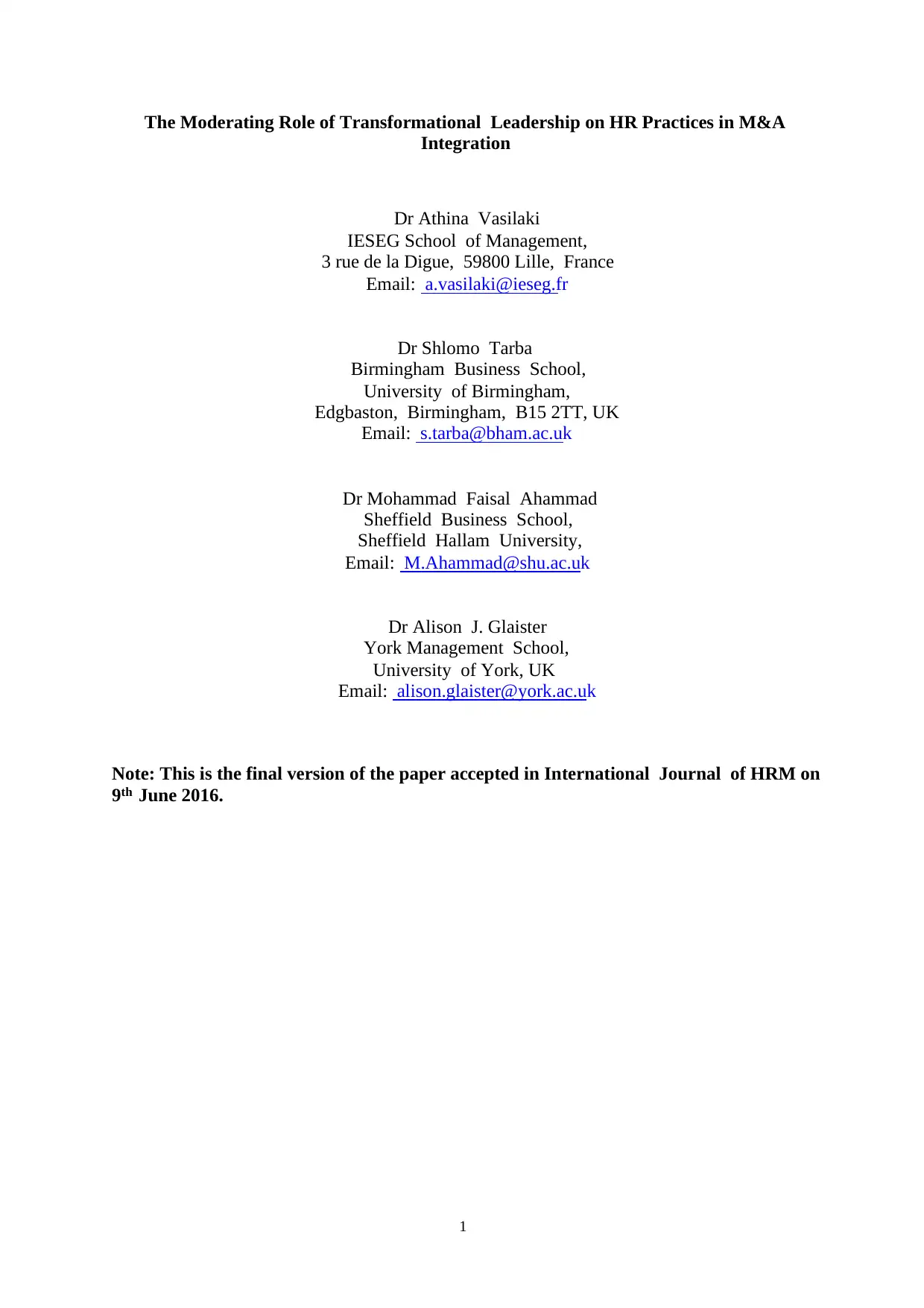
1
The Moderating Role of Transformational Leadership on HR Practices in M&A
Integration
Dr Athina Vasilaki
IESEG School of Management,
3 rue de la Digue, 59800 Lille, France
Email: a.vasilaki@ieseg.fr
Dr Shlomo Tarba
Birmingham Business School,
University of Birmingham,
Edgbaston, Birmingham, B15 2TT, UK
Email: s.tarba@bham.ac.uk
Dr Mohammad Faisal Ahammad
Sheffield Business School,
Sheffield Hallam University,
Email: M.Ahammad@shu.ac.uk
Dr Alison J. Glaister
York Management School,
University of York, UK
Email: alison.glaister@york.ac.uk
Note: This is the final version of the paper accepted in International Journal of HRM on
9th June 2016.
The Moderating Role of Transformational Leadership on HR Practices in M&A
Integration
Dr Athina Vasilaki
IESEG School of Management,
3 rue de la Digue, 59800 Lille, France
Email: a.vasilaki@ieseg.fr
Dr Shlomo Tarba
Birmingham Business School,
University of Birmingham,
Edgbaston, Birmingham, B15 2TT, UK
Email: s.tarba@bham.ac.uk
Dr Mohammad Faisal Ahammad
Sheffield Business School,
Sheffield Hallam University,
Email: M.Ahammad@shu.ac.uk
Dr Alison J. Glaister
York Management School,
University of York, UK
Email: alison.glaister@york.ac.uk
Note: This is the final version of the paper accepted in International Journal of HRM on
9th June 2016.
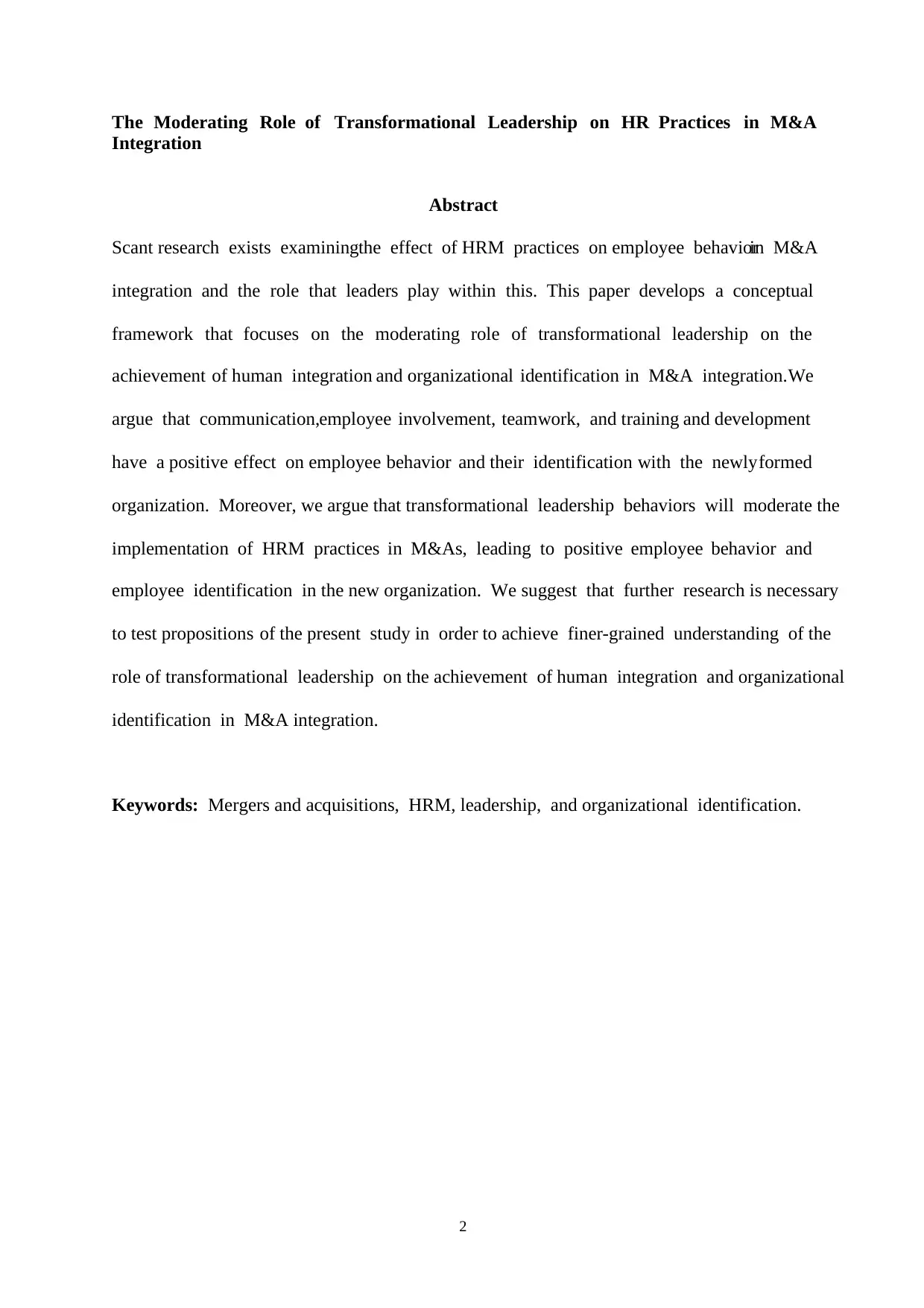
2
The Moderating Role of Transformational Leadership on HR Practices in M&A
Integration
Abstract
Scant research exists examiningthe effect of HRM practices on employee behaviorin M&A
integration and the role that leaders play within this. This paper develops a conceptual
framework that focuses on the moderating role of transformational leadership on the
achievement of human integration and organizational identification in M&A integration.We
argue that communication,employee involvement, teamwork, and training and development
have a positive effect on employee behavior and their identification with the newly formed
organization. Moreover, we argue that transformational leadership behaviors will moderate the
implementation of HRM practices in M&As, leading to positive employee behavior and
employee identification in the new organization. We suggest that further research is necessary
to test propositions of the present study in order to achieve finer-grained understanding of the
role of transformational leadership on the achievement of human integration and organizational
identification in M&A integration.
Keywords: Mergers and acquisitions, HRM, leadership, and organizational identification.
The Moderating Role of Transformational Leadership on HR Practices in M&A
Integration
Abstract
Scant research exists examiningthe effect of HRM practices on employee behaviorin M&A
integration and the role that leaders play within this. This paper develops a conceptual
framework that focuses on the moderating role of transformational leadership on the
achievement of human integration and organizational identification in M&A integration.We
argue that communication,employee involvement, teamwork, and training and development
have a positive effect on employee behavior and their identification with the newly formed
organization. Moreover, we argue that transformational leadership behaviors will moderate the
implementation of HRM practices in M&As, leading to positive employee behavior and
employee identification in the new organization. We suggest that further research is necessary
to test propositions of the present study in order to achieve finer-grained understanding of the
role of transformational leadership on the achievement of human integration and organizational
identification in M&A integration.
Keywords: Mergers and acquisitions, HRM, leadership, and organizational identification.
⊘ This is a preview!⊘
Do you want full access?
Subscribe today to unlock all pages.

Trusted by 1+ million students worldwide
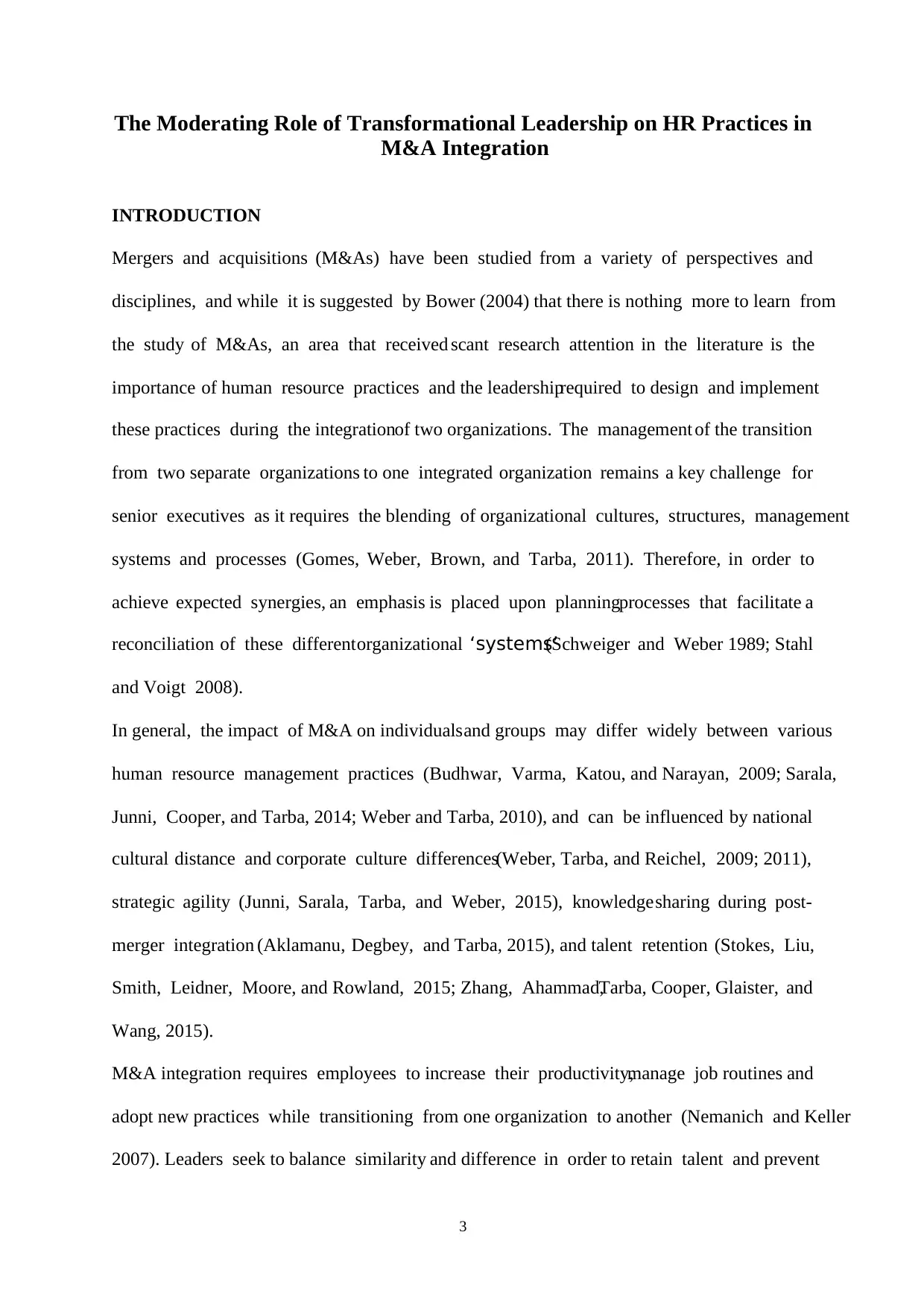
3
The Moderating Role of Transformational Leadership on HR Practices in
M&A Integration
INTRODUCTION
Mergers and acquisitions (M&As) have been studied from a variety of perspectives and
disciplines, and while it is suggested by Bower (2004) that there is nothing more to learn from
the study of M&As, an area that received scant research attention in the literature is the
importance of human resource practices and the leadershiprequired to design and implement
these practices during the integrationof two organizations. The management of the transition
from two separate organizations to one integrated organization remains a key challenge for
senior executives as it requires the blending of organizational cultures, structures, management
systems and processes (Gomes, Weber, Brown, and Tarba, 2011). Therefore, in order to
achieve expected synergies, an emphasis is placed upon planningprocesses that facilitate a
reconciliation of these different organizational ‘systems’(Schweiger and Weber 1989; Stahl
and Voigt 2008).
In general, the impact of M&A on individuals and groups may differ widely between various
human resource management practices (Budhwar, Varma, Katou, and Narayan, 2009; Sarala,
Junni, Cooper, and Tarba, 2014; Weber and Tarba, 2010), and can be influenced by national
cultural distance and corporate culture differences(Weber, Tarba, and Reichel, 2009; 2011),
strategic agility (Junni, Sarala, Tarba, and Weber, 2015), knowledge sharing during post-
merger integration (Aklamanu, Degbey, and Tarba, 2015), and talent retention (Stokes, Liu,
Smith, Leidner, Moore, and Rowland, 2015; Zhang, Ahammad,Tarba, Cooper, Glaister, and
Wang, 2015).
M&A integration requires employees to increase their productivity,manage job routines and
adopt new practices while transitioning from one organization to another (Nemanich and Keller
2007). Leaders seek to balance similarity and difference in order to retain talent and prevent
The Moderating Role of Transformational Leadership on HR Practices in
M&A Integration
INTRODUCTION
Mergers and acquisitions (M&As) have been studied from a variety of perspectives and
disciplines, and while it is suggested by Bower (2004) that there is nothing more to learn from
the study of M&As, an area that received scant research attention in the literature is the
importance of human resource practices and the leadershiprequired to design and implement
these practices during the integrationof two organizations. The management of the transition
from two separate organizations to one integrated organization remains a key challenge for
senior executives as it requires the blending of organizational cultures, structures, management
systems and processes (Gomes, Weber, Brown, and Tarba, 2011). Therefore, in order to
achieve expected synergies, an emphasis is placed upon planningprocesses that facilitate a
reconciliation of these different organizational ‘systems’(Schweiger and Weber 1989; Stahl
and Voigt 2008).
In general, the impact of M&A on individuals and groups may differ widely between various
human resource management practices (Budhwar, Varma, Katou, and Narayan, 2009; Sarala,
Junni, Cooper, and Tarba, 2014; Weber and Tarba, 2010), and can be influenced by national
cultural distance and corporate culture differences(Weber, Tarba, and Reichel, 2009; 2011),
strategic agility (Junni, Sarala, Tarba, and Weber, 2015), knowledge sharing during post-
merger integration (Aklamanu, Degbey, and Tarba, 2015), and talent retention (Stokes, Liu,
Smith, Leidner, Moore, and Rowland, 2015; Zhang, Ahammad,Tarba, Cooper, Glaister, and
Wang, 2015).
M&A integration requires employees to increase their productivity,manage job routines and
adopt new practices while transitioning from one organization to another (Nemanich and Keller
2007). Leaders seek to balance similarity and difference in order to retain talent and prevent
Paraphrase This Document
Need a fresh take? Get an instant paraphrase of this document with our AI Paraphraser
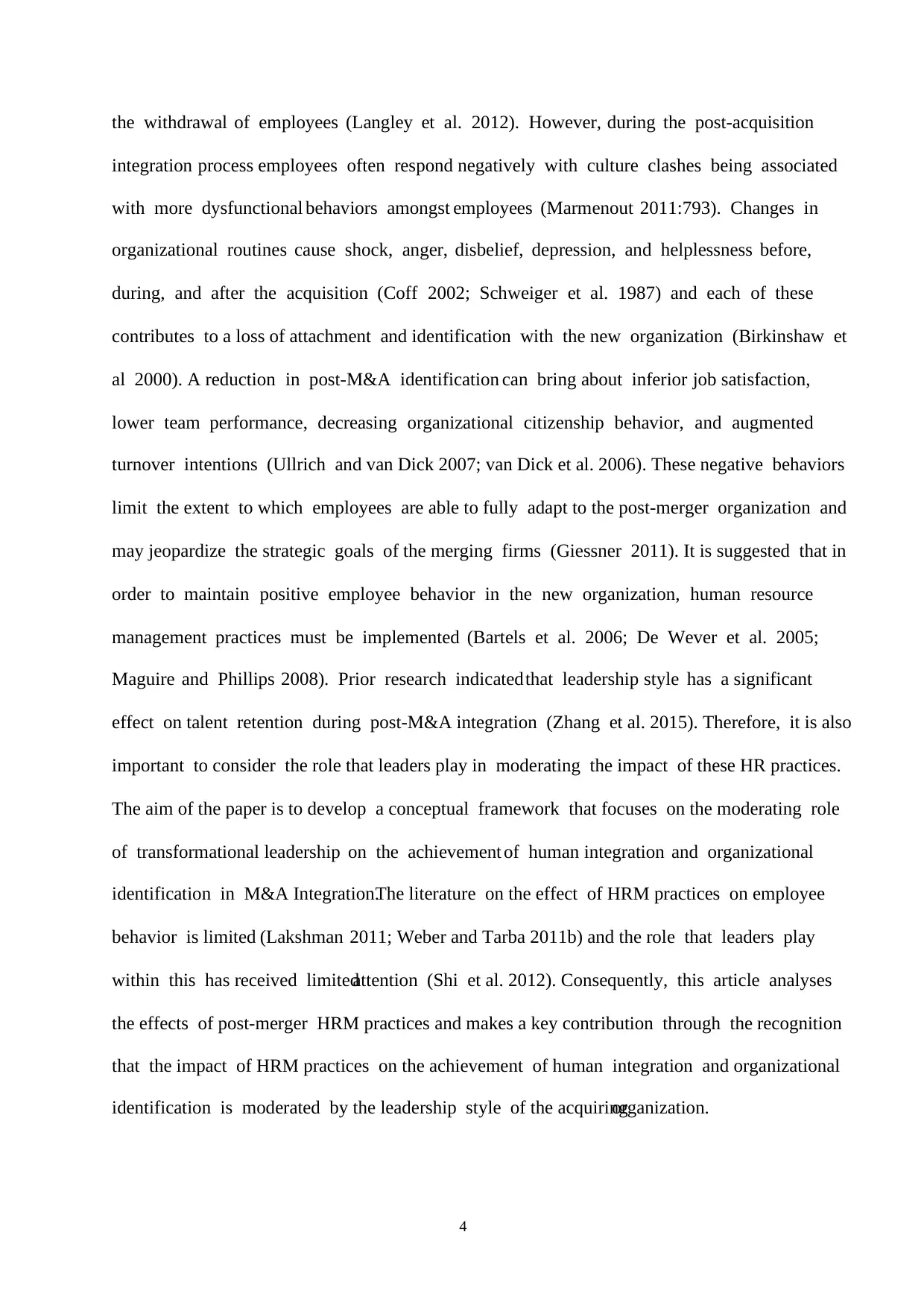
4
the withdrawal of employees (Langley et al. 2012). However, during the post-acquisition
integration process employees often respond negatively with culture clashes being associated
with more dysfunctional behaviors amongst employees (Marmenout 2011:793). Changes in
organizational routines cause shock, anger, disbelief, depression, and helplessness before,
during, and after the acquisition (Coff 2002; Schweiger et al. 1987) and each of these
contributes to a loss of attachment and identification with the new organization (Birkinshaw et
al 2000). A reduction in post-M&A identification can bring about inferior job satisfaction,
lower team performance, decreasing organizational citizenship behavior, and augmented
turnover intentions (Ullrich and van Dick 2007; van Dick et al. 2006). These negative behaviors
limit the extent to which employees are able to fully adapt to the post-merger organization and
may jeopardize the strategic goals of the merging firms (Giessner 2011). It is suggested that in
order to maintain positive employee behavior in the new organization, human resource
management practices must be implemented (Bartels et al. 2006; De Wever et al. 2005;
Maguire and Phillips 2008). Prior research indicated that leadership style has a significant
effect on talent retention during post-M&A integration (Zhang et al. 2015). Therefore, it is also
important to consider the role that leaders play in moderating the impact of these HR practices.
The aim of the paper is to develop a conceptual framework that focuses on the moderating role
of transformational leadership on the achievement of human integration and organizational
identification in M&A Integration.The literature on the effect of HRM practices on employee
behavior is limited (Lakshman 2011; Weber and Tarba 2011b) and the role that leaders play
within this has received limitedattention (Shi et al. 2012). Consequently, this article analyses
the effects of post-merger HRM practices and makes a key contribution through the recognition
that the impact of HRM practices on the achievement of human integration and organizational
identification is moderated by the leadership style of the acquiringorganization.
the withdrawal of employees (Langley et al. 2012). However, during the post-acquisition
integration process employees often respond negatively with culture clashes being associated
with more dysfunctional behaviors amongst employees (Marmenout 2011:793). Changes in
organizational routines cause shock, anger, disbelief, depression, and helplessness before,
during, and after the acquisition (Coff 2002; Schweiger et al. 1987) and each of these
contributes to a loss of attachment and identification with the new organization (Birkinshaw et
al 2000). A reduction in post-M&A identification can bring about inferior job satisfaction,
lower team performance, decreasing organizational citizenship behavior, and augmented
turnover intentions (Ullrich and van Dick 2007; van Dick et al. 2006). These negative behaviors
limit the extent to which employees are able to fully adapt to the post-merger organization and
may jeopardize the strategic goals of the merging firms (Giessner 2011). It is suggested that in
order to maintain positive employee behavior in the new organization, human resource
management practices must be implemented (Bartels et al. 2006; De Wever et al. 2005;
Maguire and Phillips 2008). Prior research indicated that leadership style has a significant
effect on talent retention during post-M&A integration (Zhang et al. 2015). Therefore, it is also
important to consider the role that leaders play in moderating the impact of these HR practices.
The aim of the paper is to develop a conceptual framework that focuses on the moderating role
of transformational leadership on the achievement of human integration and organizational
identification in M&A Integration.The literature on the effect of HRM practices on employee
behavior is limited (Lakshman 2011; Weber and Tarba 2011b) and the role that leaders play
within this has received limitedattention (Shi et al. 2012). Consequently, this article analyses
the effects of post-merger HRM practices and makes a key contribution through the recognition
that the impact of HRM practices on the achievement of human integration and organizational
identification is moderated by the leadership style of the acquiringorganization.
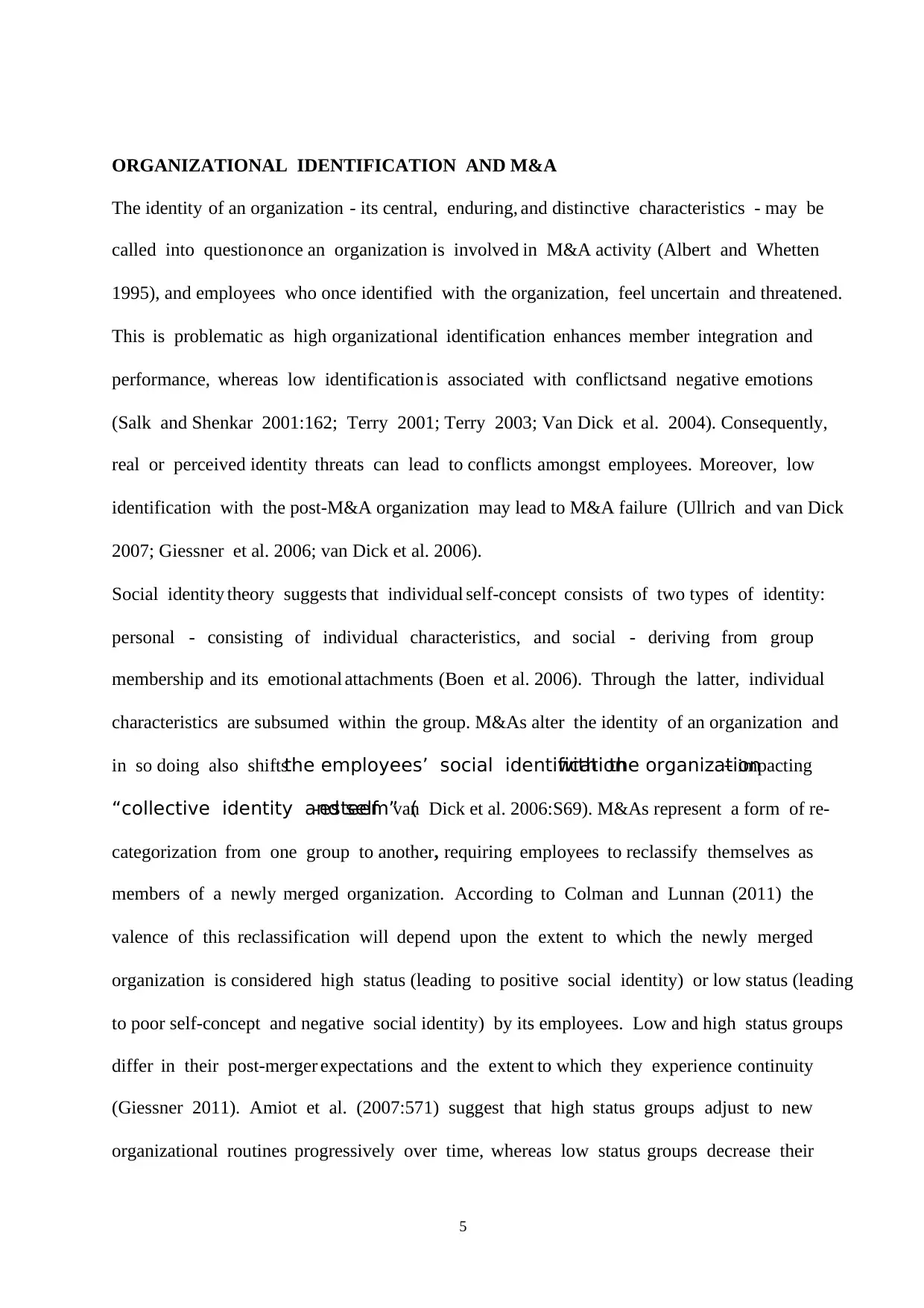
5
ORGANIZATIONAL IDENTIFICATION AND M&A
The identity of an organization - its central, enduring, and distinctive characteristics - may be
called into question once an organization is involved in M&A activity (Albert and Whetten
1995), and employees who once identified with the organization, feel uncertain and threatened.
This is problematic as high organizational identification enhances member integration and
performance, whereas low identification is associated with conflictsand negative emotions
(Salk and Shenkar 2001:162; Terry 2001; Terry 2003; Van Dick et al. 2004). Consequently,
real or perceived identity threats can lead to conflicts amongst employees. Moreover, low
identification with the post-M&A organization may lead to M&A failure (Ullrich and van Dick
2007; Giessner et al. 2006; van Dick et al. 2006).
Social identity theory suggests that individual self-concept consists of two types of identity:
personal - consisting of individual characteristics, and social - deriving from group
membership and its emotional attachments (Boen et al. 2006). Through the latter, individual
characteristics are subsumed within the group. M&As alter the identity of an organization and
in so doing also shiftsthe employees’ social identificationwith the organization– impacting
“collective identity and self-esteem” (van Dick et al. 2006:S69). M&As represent a form of re-
categorization from one group to another, requiring employees to reclassify themselves as
members of a newly merged organization. According to Colman and Lunnan (2011) the
valence of this reclassification will depend upon the extent to which the newly merged
organization is considered high status (leading to positive social identity) or low status (leading
to poor self-concept and negative social identity) by its employees. Low and high status groups
differ in their post-merger expectations and the extent to which they experience continuity
(Giessner 2011). Amiot et al. (2007:571) suggest that high status groups adjust to new
organizational routines progressively over time, whereas low status groups decrease their
ORGANIZATIONAL IDENTIFICATION AND M&A
The identity of an organization - its central, enduring, and distinctive characteristics - may be
called into question once an organization is involved in M&A activity (Albert and Whetten
1995), and employees who once identified with the organization, feel uncertain and threatened.
This is problematic as high organizational identification enhances member integration and
performance, whereas low identification is associated with conflictsand negative emotions
(Salk and Shenkar 2001:162; Terry 2001; Terry 2003; Van Dick et al. 2004). Consequently,
real or perceived identity threats can lead to conflicts amongst employees. Moreover, low
identification with the post-M&A organization may lead to M&A failure (Ullrich and van Dick
2007; Giessner et al. 2006; van Dick et al. 2006).
Social identity theory suggests that individual self-concept consists of two types of identity:
personal - consisting of individual characteristics, and social - deriving from group
membership and its emotional attachments (Boen et al. 2006). Through the latter, individual
characteristics are subsumed within the group. M&As alter the identity of an organization and
in so doing also shiftsthe employees’ social identificationwith the organization– impacting
“collective identity and self-esteem” (van Dick et al. 2006:S69). M&As represent a form of re-
categorization from one group to another, requiring employees to reclassify themselves as
members of a newly merged organization. According to Colman and Lunnan (2011) the
valence of this reclassification will depend upon the extent to which the newly merged
organization is considered high status (leading to positive social identity) or low status (leading
to poor self-concept and negative social identity) by its employees. Low and high status groups
differ in their post-merger expectations and the extent to which they experience continuity
(Giessner 2011). Amiot et al. (2007:571) suggest that high status groups adjust to new
organizational routines progressively over time, whereas low status groups decrease their
⊘ This is a preview!⊘
Do you want full access?
Subscribe today to unlock all pages.

Trusted by 1+ million students worldwide
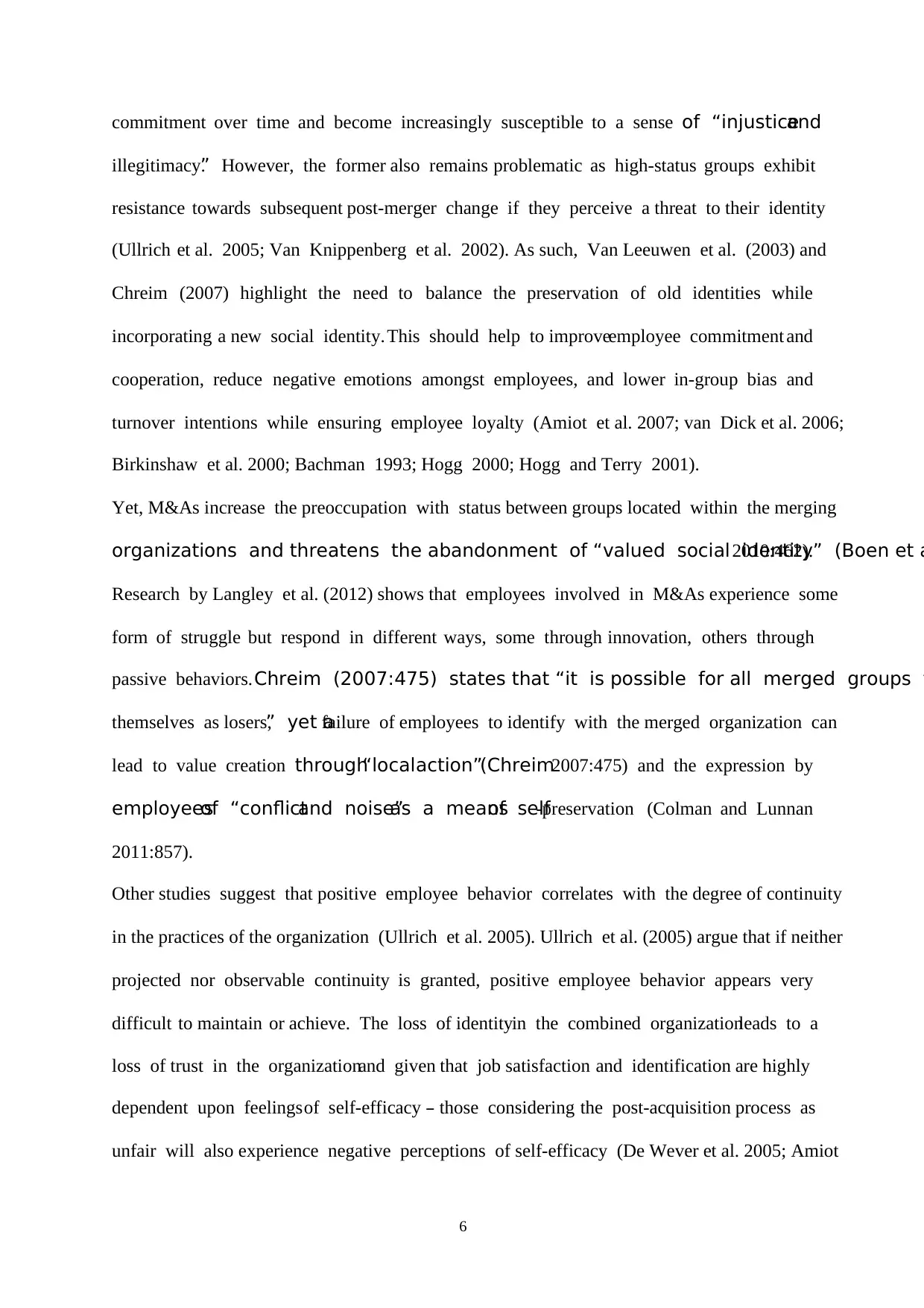
6
commitment over time and become increasingly susceptible to a sense of “injusticeand
illegitimacy.” However, the former also remains problematic as high-status groups exhibit
resistance towards subsequent post-merger change if they perceive a threat to their identity
(Ullrich et al. 2005; Van Knippenberg et al. 2002). As such, Van Leeuwen et al. (2003) and
Chreim (2007) highlight the need to balance the preservation of old identities while
incorporating a new social identity. This should help to improveemployee commitment and
cooperation, reduce negative emotions amongst employees, and lower in-group bias and
turnover intentions while ensuring employee loyalty (Amiot et al. 2007; van Dick et al. 2006;
Birkinshaw et al. 2000; Bachman 1993; Hogg 2000; Hogg and Terry 2001).
Yet, M&As increase the preoccupation with status between groups located within the merging
organizations and threatens the abandonment of “valued social identity” (Boen et a2010:462).
Research by Langley et al. (2012) shows that employees involved in M&As experience some
form of struggle but respond in different ways, some through innovation, others through
passive behaviors. Chreim (2007:475) states that “it is possible for all merged groups t
themselves as losers,” yet afailure of employees to identify with the merged organization can
lead to value creation through“localaction”(Chreim2007:475) and the expression by
employeesof “conflictand noise”as a meansof self-preservation (Colman and Lunnan
2011:857).
Other studies suggest that positive employee behavior correlates with the degree of continuity
in the practices of the organization (Ullrich et al. 2005). Ullrich et al. (2005) argue that if neither
projected nor observable continuity is granted, positive employee behavior appears very
difficult to maintain or achieve. The loss of identityin the combined organizationleads to a
loss of trust in the organizationand given that job satisfaction and identification are highly
dependent upon feelings of self-efficacy – those considering the post-acquisition process as
unfair will also experience negative perceptions of self-efficacy (De Wever et al. 2005; Amiot
commitment over time and become increasingly susceptible to a sense of “injusticeand
illegitimacy.” However, the former also remains problematic as high-status groups exhibit
resistance towards subsequent post-merger change if they perceive a threat to their identity
(Ullrich et al. 2005; Van Knippenberg et al. 2002). As such, Van Leeuwen et al. (2003) and
Chreim (2007) highlight the need to balance the preservation of old identities while
incorporating a new social identity. This should help to improveemployee commitment and
cooperation, reduce negative emotions amongst employees, and lower in-group bias and
turnover intentions while ensuring employee loyalty (Amiot et al. 2007; van Dick et al. 2006;
Birkinshaw et al. 2000; Bachman 1993; Hogg 2000; Hogg and Terry 2001).
Yet, M&As increase the preoccupation with status between groups located within the merging
organizations and threatens the abandonment of “valued social identity” (Boen et a2010:462).
Research by Langley et al. (2012) shows that employees involved in M&As experience some
form of struggle but respond in different ways, some through innovation, others through
passive behaviors. Chreim (2007:475) states that “it is possible for all merged groups t
themselves as losers,” yet afailure of employees to identify with the merged organization can
lead to value creation through“localaction”(Chreim2007:475) and the expression by
employeesof “conflictand noise”as a meansof self-preservation (Colman and Lunnan
2011:857).
Other studies suggest that positive employee behavior correlates with the degree of continuity
in the practices of the organization (Ullrich et al. 2005). Ullrich et al. (2005) argue that if neither
projected nor observable continuity is granted, positive employee behavior appears very
difficult to maintain or achieve. The loss of identityin the combined organizationleads to a
loss of trust in the organizationand given that job satisfaction and identification are highly
dependent upon feelings of self-efficacy – those considering the post-acquisition process as
unfair will also experience negative perceptions of self-efficacy (De Wever et al. 2005; Amiot
Paraphrase This Document
Need a fresh take? Get an instant paraphrase of this document with our AI Paraphraser
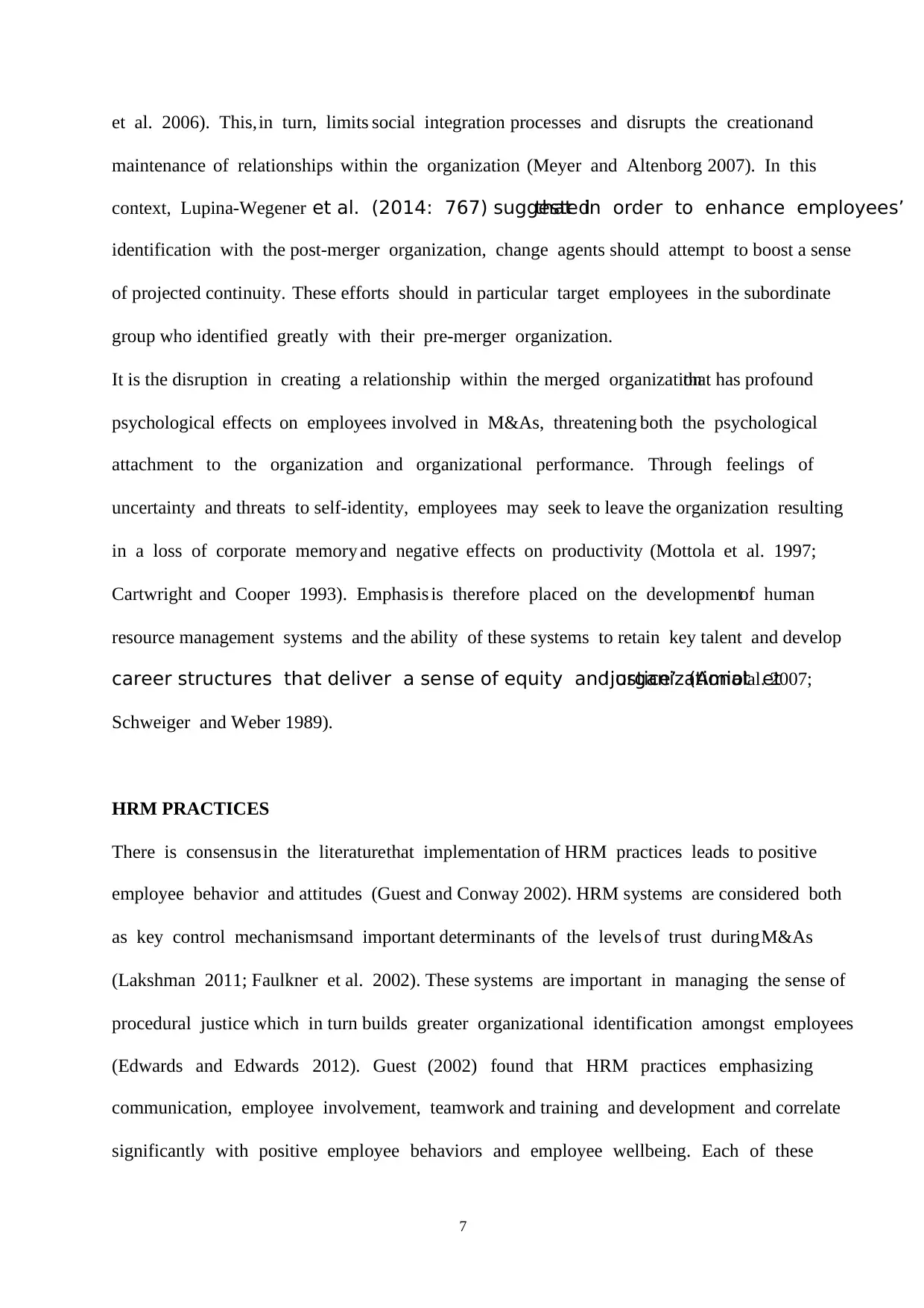
7
et al. 2006). This, in turn, limits social integration processes and disrupts the creationand
maintenance of relationships within the organization (Meyer and Altenborg 2007). In this
context, Lupina-Wegener et al. (2014: 767) suggestedthat in order to enhance employees’
identification with the post-merger organization, change agents should attempt to boost a sense
of projected continuity. These efforts should in particular target employees in the subordinate
group who identified greatly with their pre-merger organization.
It is the disruption in creating a relationship within the merged organizationthat has profound
psychological effects on employees involved in M&As, threatening both the psychological
attachment to the organization and organizational performance. Through feelings of
uncertainty and threats to self-identity, employees may seek to leave the organization resulting
in a loss of corporate memory and negative effects on productivity (Mottola et al. 1997;
Cartwright and Cooper 1993). Emphasis is therefore placed on the developmentof human
resource management systems and the ability of these systems to retain key talent and develop
career structures that deliver a sense of equity and organizational‘justice’ (Amiot etal. 2007;
Schweiger and Weber 1989).
HRM PRACTICES
There is consensus in the literaturethat implementation of HRM practices leads to positive
employee behavior and attitudes (Guest and Conway 2002). HRM systems are considered both
as key control mechanismsand important determinants of the levels of trust during M&As
(Lakshman 2011; Faulkner et al. 2002). These systems are important in managing the sense of
procedural justice which in turn builds greater organizational identification amongst employees
(Edwards and Edwards 2012). Guest (2002) found that HRM practices emphasizing
communication, employee involvement, teamwork and training and development and correlate
significantly with positive employee behaviors and employee wellbeing. Each of these
et al. 2006). This, in turn, limits social integration processes and disrupts the creationand
maintenance of relationships within the organization (Meyer and Altenborg 2007). In this
context, Lupina-Wegener et al. (2014: 767) suggestedthat in order to enhance employees’
identification with the post-merger organization, change agents should attempt to boost a sense
of projected continuity. These efforts should in particular target employees in the subordinate
group who identified greatly with their pre-merger organization.
It is the disruption in creating a relationship within the merged organizationthat has profound
psychological effects on employees involved in M&As, threatening both the psychological
attachment to the organization and organizational performance. Through feelings of
uncertainty and threats to self-identity, employees may seek to leave the organization resulting
in a loss of corporate memory and negative effects on productivity (Mottola et al. 1997;
Cartwright and Cooper 1993). Emphasis is therefore placed on the developmentof human
resource management systems and the ability of these systems to retain key talent and develop
career structures that deliver a sense of equity and organizational‘justice’ (Amiot etal. 2007;
Schweiger and Weber 1989).
HRM PRACTICES
There is consensus in the literaturethat implementation of HRM practices leads to positive
employee behavior and attitudes (Guest and Conway 2002). HRM systems are considered both
as key control mechanismsand important determinants of the levels of trust during M&As
(Lakshman 2011; Faulkner et al. 2002). These systems are important in managing the sense of
procedural justice which in turn builds greater organizational identification amongst employees
(Edwards and Edwards 2012). Guest (2002) found that HRM practices emphasizing
communication, employee involvement, teamwork and training and development and correlate
significantly with positive employee behaviors and employee wellbeing. Each of these
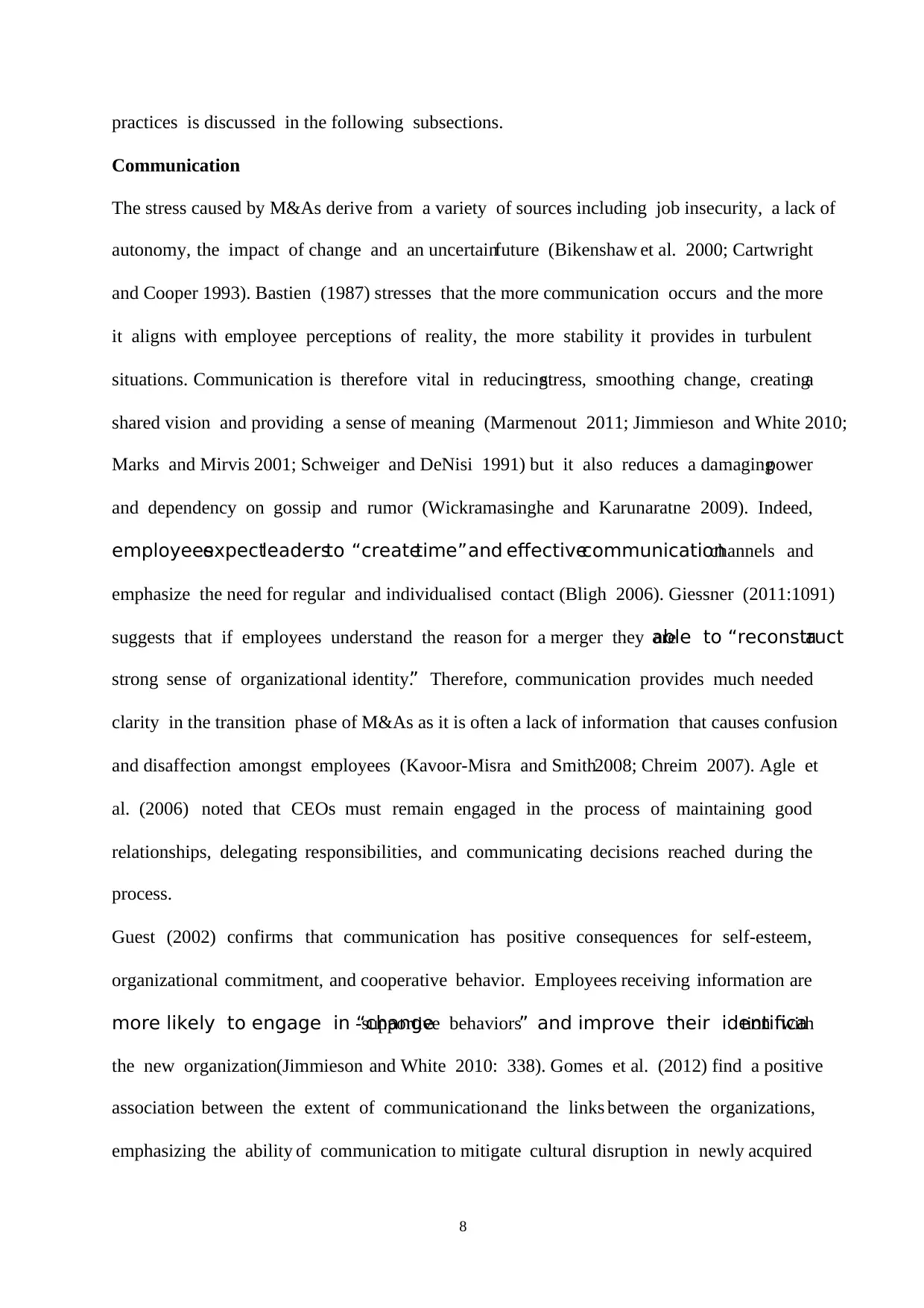
8
practices is discussed in the following subsections.
Communication
The stress caused by M&As derive from a variety of sources including job insecurity, a lack of
autonomy, the impact of change and an uncertainfuture (Bikenshaw et al. 2000; Cartwright
and Cooper 1993). Bastien (1987) stresses that the more communication occurs and the more
it aligns with employee perceptions of reality, the more stability it provides in turbulent
situations. Communication is therefore vital in reducingstress, smoothing change, creatinga
shared vision and providing a sense of meaning (Marmenout 2011; Jimmieson and White 2010;
Marks and Mirvis 2001; Schweiger and DeNisi 1991) but it also reduces a damagingpower
and dependency on gossip and rumor (Wickramasinghe and Karunaratne 2009). Indeed,
employeesexpectleadersto “createtime” and effectivecommunicationchannels and
emphasize the need for regular and individualised contact (Bligh 2006). Giessner (2011:1091)
suggests that if employees understand the reason for a merger they areable to “reconstructa
strong sense of organizational identity.” Therefore, communication provides much needed
clarity in the transition phase of M&As as it is often a lack of information that causes confusion
and disaffection amongst employees (Kavoor-Misra and Smith2008; Chreim 2007). Agle et
al. (2006) noted that CEOs must remain engaged in the process of maintaining good
relationships, delegating responsibilities, and communicating decisions reached during the
process.
Guest (2002) confirms that communication has positive consequences for self-esteem,
organizational commitment, and cooperative behavior. Employees receiving information are
more likely to engage in “change-supportive behaviors” and improve their identification with
the new organization(Jimmieson and White 2010: 338). Gomes et al. (2012) find a positive
association between the extent of communication and the links between the organizations,
emphasizing the ability of communication to mitigate cultural disruption in newly acquired
practices is discussed in the following subsections.
Communication
The stress caused by M&As derive from a variety of sources including job insecurity, a lack of
autonomy, the impact of change and an uncertainfuture (Bikenshaw et al. 2000; Cartwright
and Cooper 1993). Bastien (1987) stresses that the more communication occurs and the more
it aligns with employee perceptions of reality, the more stability it provides in turbulent
situations. Communication is therefore vital in reducingstress, smoothing change, creatinga
shared vision and providing a sense of meaning (Marmenout 2011; Jimmieson and White 2010;
Marks and Mirvis 2001; Schweiger and DeNisi 1991) but it also reduces a damagingpower
and dependency on gossip and rumor (Wickramasinghe and Karunaratne 2009). Indeed,
employeesexpectleadersto “createtime” and effectivecommunicationchannels and
emphasize the need for regular and individualised contact (Bligh 2006). Giessner (2011:1091)
suggests that if employees understand the reason for a merger they areable to “reconstructa
strong sense of organizational identity.” Therefore, communication provides much needed
clarity in the transition phase of M&As as it is often a lack of information that causes confusion
and disaffection amongst employees (Kavoor-Misra and Smith2008; Chreim 2007). Agle et
al. (2006) noted that CEOs must remain engaged in the process of maintaining good
relationships, delegating responsibilities, and communicating decisions reached during the
process.
Guest (2002) confirms that communication has positive consequences for self-esteem,
organizational commitment, and cooperative behavior. Employees receiving information are
more likely to engage in “change-supportive behaviors” and improve their identification with
the new organization(Jimmieson and White 2010: 338). Gomes et al. (2012) find a positive
association between the extent of communication and the links between the organizations,
emphasizing the ability of communication to mitigate cultural disruption in newly acquired
⊘ This is a preview!⊘
Do you want full access?
Subscribe today to unlock all pages.

Trusted by 1+ million students worldwide
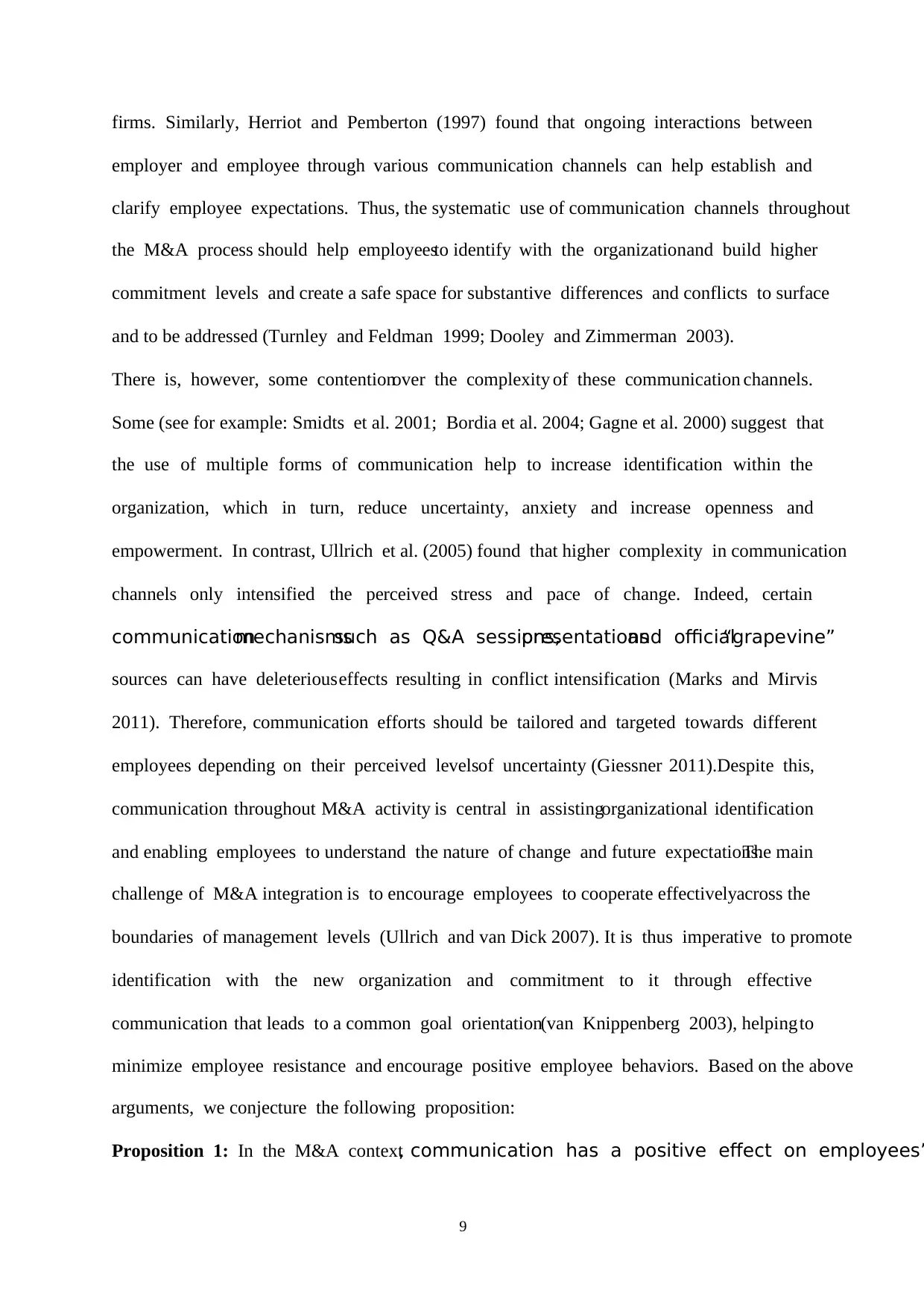
9
firms. Similarly, Herriot and Pemberton (1997) found that ongoing interactions between
employer and employee through various communication channels can help establish and
clarify employee expectations. Thus, the systematic use of communication channels throughout
the M&A process should help employeesto identify with the organizationand build higher
commitment levels and create a safe space for substantive differences and conflicts to surface
and to be addressed (Turnley and Feldman 1999; Dooley and Zimmerman 2003).
There is, however, some contentionover the complexity of these communication channels.
Some (see for example: Smidts et al. 2001; Bordia et al. 2004; Gagne et al. 2000) suggest that
the use of multiple forms of communication help to increase identification within the
organization, which in turn, reduce uncertainty, anxiety and increase openness and
empowerment. In contrast, Ullrich et al. (2005) found that higher complexity in communication
channels only intensified the perceived stress and pace of change. Indeed, certain
communicationmechanismssuch as Q&A sessions,presentationsand official“grapevine”
sources can have deleterious effects resulting in conflict intensification (Marks and Mirvis
2011). Therefore, communication efforts should be tailored and targeted towards different
employees depending on their perceived levelsof uncertainty (Giessner 2011).Despite this,
communication throughout M&A activity is central in assistingorganizational identification
and enabling employees to understand the nature of change and future expectations.The main
challenge of M&A integration is to encourage employees to cooperate effectivelyacross the
boundaries of management levels (Ullrich and van Dick 2007). It is thus imperative to promote
identification with the new organization and commitment to it through effective
communication that leads to a common goal orientation(van Knippenberg 2003), helping to
minimize employee resistance and encourage positive employee behaviors. Based on the above
arguments, we conjecture the following proposition:
Proposition 1: In the M&A context, communication has a positive effect on employees’
firms. Similarly, Herriot and Pemberton (1997) found that ongoing interactions between
employer and employee through various communication channels can help establish and
clarify employee expectations. Thus, the systematic use of communication channels throughout
the M&A process should help employeesto identify with the organizationand build higher
commitment levels and create a safe space for substantive differences and conflicts to surface
and to be addressed (Turnley and Feldman 1999; Dooley and Zimmerman 2003).
There is, however, some contentionover the complexity of these communication channels.
Some (see for example: Smidts et al. 2001; Bordia et al. 2004; Gagne et al. 2000) suggest that
the use of multiple forms of communication help to increase identification within the
organization, which in turn, reduce uncertainty, anxiety and increase openness and
empowerment. In contrast, Ullrich et al. (2005) found that higher complexity in communication
channels only intensified the perceived stress and pace of change. Indeed, certain
communicationmechanismssuch as Q&A sessions,presentationsand official“grapevine”
sources can have deleterious effects resulting in conflict intensification (Marks and Mirvis
2011). Therefore, communication efforts should be tailored and targeted towards different
employees depending on their perceived levelsof uncertainty (Giessner 2011).Despite this,
communication throughout M&A activity is central in assistingorganizational identification
and enabling employees to understand the nature of change and future expectations.The main
challenge of M&A integration is to encourage employees to cooperate effectivelyacross the
boundaries of management levels (Ullrich and van Dick 2007). It is thus imperative to promote
identification with the new organization and commitment to it through effective
communication that leads to a common goal orientation(van Knippenberg 2003), helping to
minimize employee resistance and encourage positive employee behaviors. Based on the above
arguments, we conjecture the following proposition:
Proposition 1: In the M&A context, communication has a positive effect on employees’
Paraphrase This Document
Need a fresh take? Get an instant paraphrase of this document with our AI Paraphraser
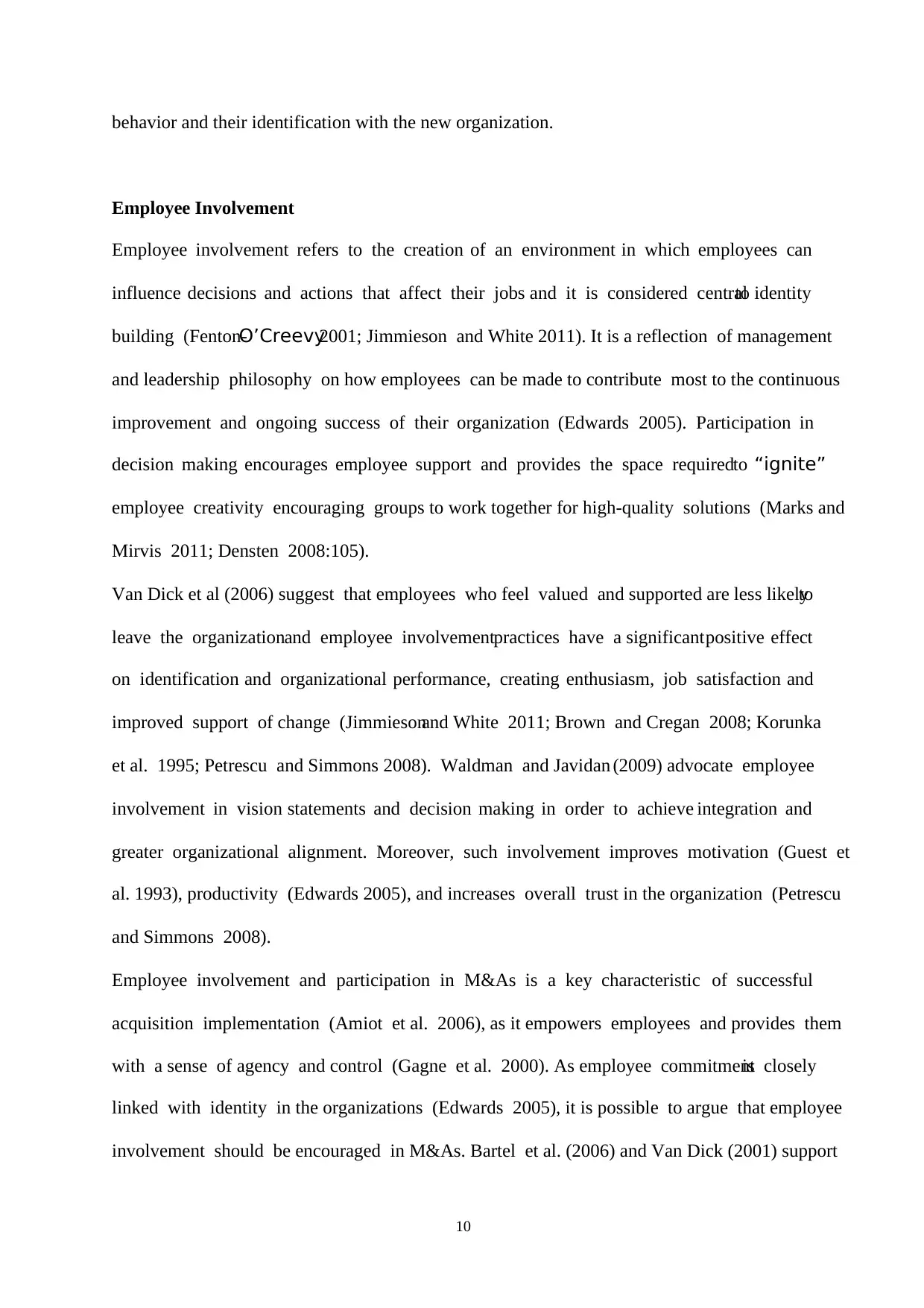
10
behavior and their identification with the new organization.
Employee Involvement
Employee involvement refers to the creation of an environment in which employees can
influence decisions and actions that affect their jobs and it is considered centralto identity
building (Fenton-O’Creevy2001; Jimmieson and White 2011). It is a reflection of management
and leadership philosophy on how employees can be made to contribute most to the continuous
improvement and ongoing success of their organization (Edwards 2005). Participation in
decision making encourages employee support and provides the space requiredto “ignite”
employee creativity encouraging groups to work together for high-quality solutions (Marks and
Mirvis 2011; Densten 2008:105).
Van Dick et al (2006) suggest that employees who feel valued and supported are less likelyto
leave the organizationand employee involvementpractices have a significant positive effect
on identification and organizational performance, creating enthusiasm, job satisfaction and
improved support of change (Jimmiesonand White 2011; Brown and Cregan 2008; Korunka
et al. 1995; Petrescu and Simmons 2008). Waldman and Javidan (2009) advocate employee
involvement in vision statements and decision making in order to achieve integration and
greater organizational alignment. Moreover, such involvement improves motivation (Guest et
al. 1993), productivity (Edwards 2005), and increases overall trust in the organization (Petrescu
and Simmons 2008).
Employee involvement and participation in M&As is a key characteristic of successful
acquisition implementation (Amiot et al. 2006), as it empowers employees and provides them
with a sense of agency and control (Gagne et al. 2000). As employee commitmentis closely
linked with identity in the organizations (Edwards 2005), it is possible to argue that employee
involvement should be encouraged in M&As. Bartel et al. (2006) and Van Dick (2001) support
behavior and their identification with the new organization.
Employee Involvement
Employee involvement refers to the creation of an environment in which employees can
influence decisions and actions that affect their jobs and it is considered centralto identity
building (Fenton-O’Creevy2001; Jimmieson and White 2011). It is a reflection of management
and leadership philosophy on how employees can be made to contribute most to the continuous
improvement and ongoing success of their organization (Edwards 2005). Participation in
decision making encourages employee support and provides the space requiredto “ignite”
employee creativity encouraging groups to work together for high-quality solutions (Marks and
Mirvis 2011; Densten 2008:105).
Van Dick et al (2006) suggest that employees who feel valued and supported are less likelyto
leave the organizationand employee involvementpractices have a significant positive effect
on identification and organizational performance, creating enthusiasm, job satisfaction and
improved support of change (Jimmiesonand White 2011; Brown and Cregan 2008; Korunka
et al. 1995; Petrescu and Simmons 2008). Waldman and Javidan (2009) advocate employee
involvement in vision statements and decision making in order to achieve integration and
greater organizational alignment. Moreover, such involvement improves motivation (Guest et
al. 1993), productivity (Edwards 2005), and increases overall trust in the organization (Petrescu
and Simmons 2008).
Employee involvement and participation in M&As is a key characteristic of successful
acquisition implementation (Amiot et al. 2006), as it empowers employees and provides them
with a sense of agency and control (Gagne et al. 2000). As employee commitmentis closely
linked with identity in the organizations (Edwards 2005), it is possible to argue that employee
involvement should be encouraged in M&As. Bartel et al. (2006) and Van Dick (2001) support
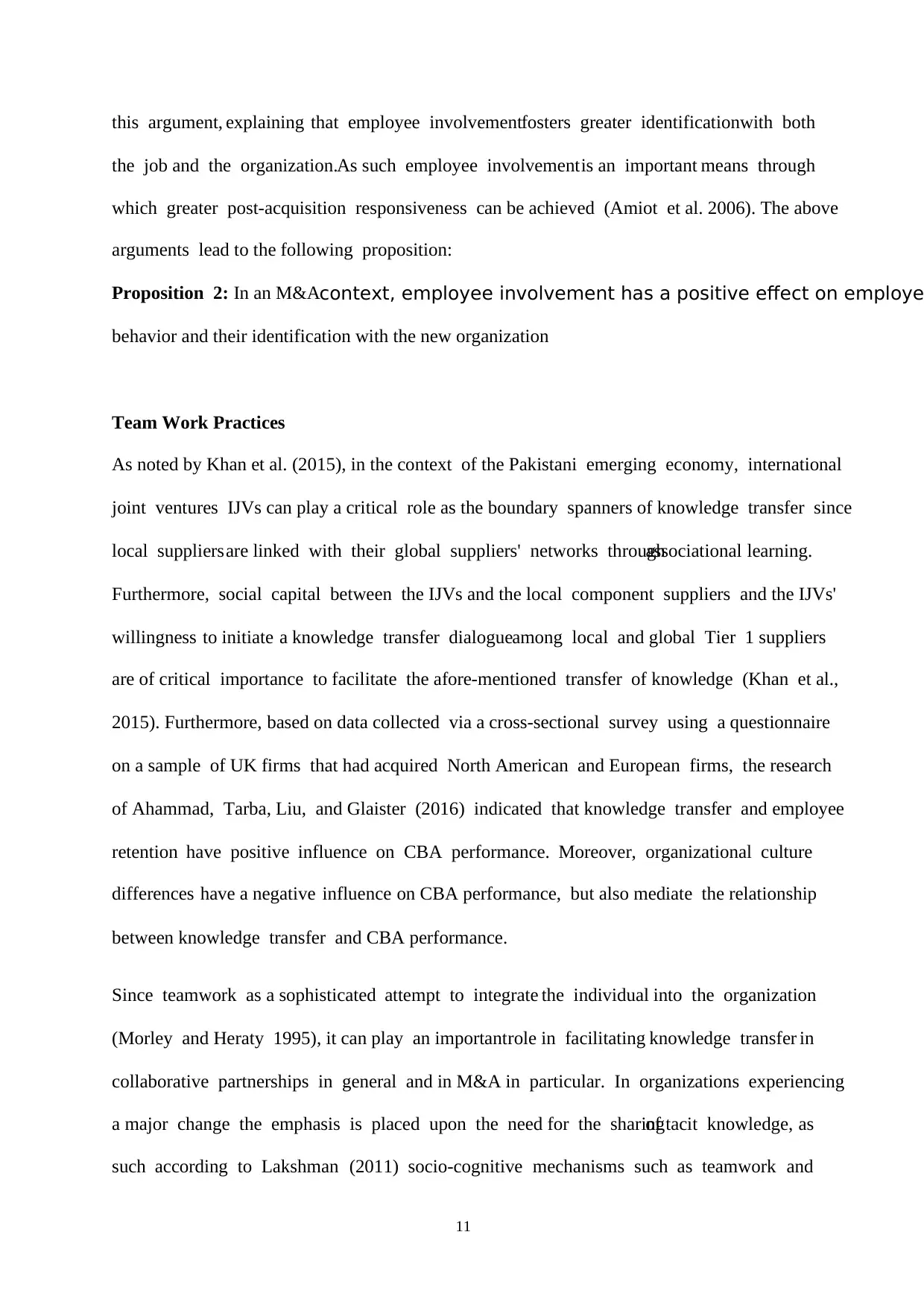
11
this argument, explaining that employee involvementfosters greater identificationwith both
the job and the organization.As such employee involvement is an important means through
which greater post-acquisition responsiveness can be achieved (Amiot et al. 2006). The above
arguments lead to the following proposition:
Proposition 2: In an M&Acontext, employee involvement has a positive effect on employe
behavior and their identification with the new organization
Team Work Practices
As noted by Khan et al. (2015), in the context of the Pakistani emerging economy, international
joint ventures IJVs can play a critical role as the boundary spanners of knowledge transfer since
local suppliers are linked with their global suppliers' networks throughassociational learning.
Furthermore, social capital between the IJVs and the local component suppliers and the IJVs'
willingness to initiate a knowledge transfer dialogueamong local and global Tier 1 suppliers
are of critical importance to facilitate the afore-mentioned transfer of knowledge (Khan et al.,
2015). Furthermore, based on data collected via a cross-sectional survey using a questionnaire
on a sample of UK firms that had acquired North American and European firms, the research
of Ahammad, Tarba, Liu, and Glaister (2016) indicated that knowledge transfer and employee
retention have positive influence on CBA performance. Moreover, organizational culture
differences have a negative influence on CBA performance, but also mediate the relationship
between knowledge transfer and CBA performance.
Since teamwork as a sophisticated attempt to integrate the individual into the organization
(Morley and Heraty 1995), it can play an important role in facilitating knowledge transfer in
collaborative partnerships in general and in M&A in particular. In organizations experiencing
a major change the emphasis is placed upon the need for the sharingof tacit knowledge, as
such according to Lakshman (2011) socio-cognitive mechanisms such as teamwork and
this argument, explaining that employee involvementfosters greater identificationwith both
the job and the organization.As such employee involvement is an important means through
which greater post-acquisition responsiveness can be achieved (Amiot et al. 2006). The above
arguments lead to the following proposition:
Proposition 2: In an M&Acontext, employee involvement has a positive effect on employe
behavior and their identification with the new organization
Team Work Practices
As noted by Khan et al. (2015), in the context of the Pakistani emerging economy, international
joint ventures IJVs can play a critical role as the boundary spanners of knowledge transfer since
local suppliers are linked with their global suppliers' networks throughassociational learning.
Furthermore, social capital between the IJVs and the local component suppliers and the IJVs'
willingness to initiate a knowledge transfer dialogueamong local and global Tier 1 suppliers
are of critical importance to facilitate the afore-mentioned transfer of knowledge (Khan et al.,
2015). Furthermore, based on data collected via a cross-sectional survey using a questionnaire
on a sample of UK firms that had acquired North American and European firms, the research
of Ahammad, Tarba, Liu, and Glaister (2016) indicated that knowledge transfer and employee
retention have positive influence on CBA performance. Moreover, organizational culture
differences have a negative influence on CBA performance, but also mediate the relationship
between knowledge transfer and CBA performance.
Since teamwork as a sophisticated attempt to integrate the individual into the organization
(Morley and Heraty 1995), it can play an important role in facilitating knowledge transfer in
collaborative partnerships in general and in M&A in particular. In organizations experiencing
a major change the emphasis is placed upon the need for the sharingof tacit knowledge, as
such according to Lakshman (2011) socio-cognitive mechanisms such as teamwork and
⊘ This is a preview!⊘
Do you want full access?
Subscribe today to unlock all pages.

Trusted by 1+ million students worldwide
1 out of 33
Your All-in-One AI-Powered Toolkit for Academic Success.
+13062052269
info@desklib.com
Available 24*7 on WhatsApp / Email
![[object Object]](/_next/static/media/star-bottom.7253800d.svg)
Unlock your academic potential
Copyright © 2020–2025 A2Z Services. All Rights Reserved. Developed and managed by ZUCOL.